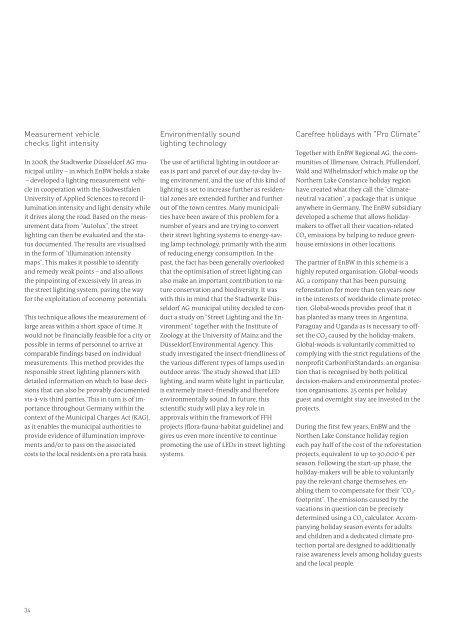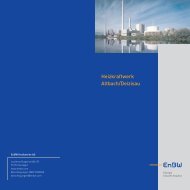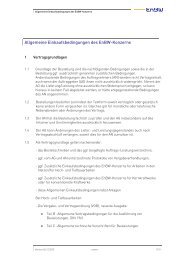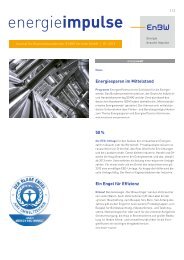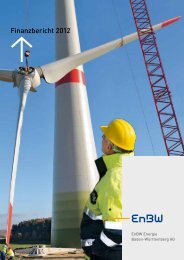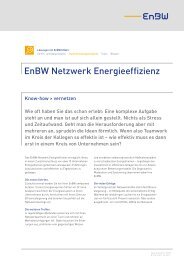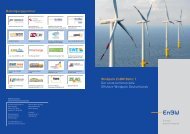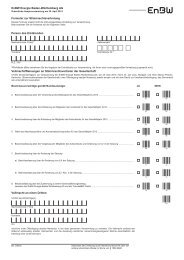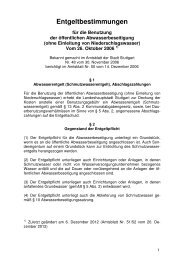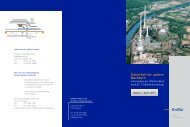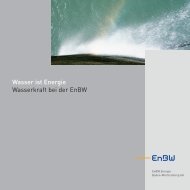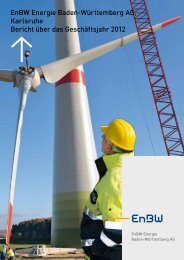2008 I 2009 Sustainability Report - Econsense
2008 I 2009 Sustainability Report - Econsense
2008 I 2009 Sustainability Report - Econsense
Create successful ePaper yourself
Turn your PDF publications into a flip-book with our unique Google optimized e-Paper software.
Measurement vehicle<br />
checks light intensity<br />
In <strong>2008</strong>, the Stadtwerke Düsseldorf AG municipal<br />
utility – in which EnBW holds a stake<br />
– developed a lighting measurement vehicle<br />
in cooperation with the Südwestfalen<br />
University of Applied Sciences to record illumination<br />
intensity and light density while<br />
it drives along the road. Based on the measurement<br />
data from "Autolux", the street<br />
lighting can then be evaluated and the status<br />
documented. The results are visualised<br />
in the form of "illumination intensity<br />
maps". This makes it possible to identify<br />
and remedy weak points – and also allows<br />
the pinpointing of excessively lit areas in<br />
the street lighting system, paving the way<br />
for the exploitation of economy potentials.<br />
This technique allows the measurement of<br />
large areas within a short space of time. It<br />
would not be financially feasible for a city or<br />
possible in terms of personnel to arrive at<br />
comparable findings based on individual<br />
measurements. This method provides the<br />
responsible street lighting planners with<br />
detailed information on which to base decisions<br />
that can also be provably documented<br />
vis-à-vis third parties. This in turn is of importance<br />
throughout Germany within the<br />
context of the Municipal Charges Act (KAG),<br />
as it enables the municipal authorities to<br />
provide evidence of illumination improvements<br />
and/or to pass on the associated<br />
costs to the local residents on a pro rata basis.<br />
34<br />
Environmentally sound<br />
lighting technology<br />
The use of artificial lighting in outdoor areas<br />
is part and parcel of our day-to-day living<br />
environment, and the use of this kind of<br />
lighting is set to increase further as residential<br />
zones are extended further and further<br />
out of the town centres. Many municipalities<br />
have been aware of this problem for a<br />
number of years and are trying to convert<br />
their street lighting systems to energy-saving<br />
lamp technology, primarily with the aim<br />
of reducing energy consumption. In the<br />
past, the fact has been generally overlooked<br />
that the optimisation of street lighting can<br />
also make an important contribution to nature<br />
conservation and biodiversity. It was<br />
with this in mind that the Stadtwerke Düsseldorf<br />
AG municipal utility decided to conduct<br />
a study on "Street Lighting and the Environment"<br />
together with the Institute of<br />
Zoology at the University of Mainz and the<br />
Düsseldorf Environmental Agency. This<br />
study investigated the insect-friendliness of<br />
the various different types of lamps used in<br />
outdoor areas. The study showed that LED<br />
lighting, and warm white light in particular,<br />
is extremely insect-friendly and therefore<br />
environmentally sound. In future, this<br />
scientific study will play a key role in<br />
approvals within the framework of FFH<br />
projects (flora-fauna-habitat guideline) and<br />
gives us even more incentive to continue<br />
promoting the use of LEDs in street lighting<br />
systems.<br />
Carefree holidays with "Pro Climate"<br />
Together with EnBW Regional AG, the communities<br />
of Illmensee, Ostrach, Pfullendorf,<br />
Wald and Wilhelmsdorf which make up the<br />
Northern Lake Constance holiday region<br />
have created what they call the "climateneutral<br />
vacation", a package that is unique<br />
anywhere in Germany. The EnBW subsidiary<br />
developed a scheme that allows holidaymakers<br />
to offset all their vacation-related<br />
CO 2 emissions by helping to reduce greenhouse<br />
emissions in other locations.<br />
The partner of EnBW in this scheme is a<br />
highly reputed organisation: Global-woods<br />
AG, a company that has been pursuing<br />
reforestation for more than ten years now<br />
in the interests of worldwide climate protection.<br />
Global-woods provides proof that it<br />
has planted as many trees in Argentina,<br />
Paraguay and Uganda as is necessary to offset<br />
the CO 2 caused by the holiday-makers.<br />
Global-woods is voluntarily committed to<br />
complying with the strict regulations of the<br />
nonprofit CarbonFixStandards, an organisation<br />
that is recognised by both political<br />
decision-makers and environmental protection<br />
organisations. 25 cents per holiday<br />
guest and overnight stay are invested in the<br />
projects.<br />
During the first few years, EnBW and the<br />
Northen Lake Constance holiday region<br />
each pay half of the cost of the reforestation<br />
projects, equivalent to up to 30,000 € per<br />
season. Following the start-up phase, the<br />
holiday-makers will be able to voluntarily<br />
pay the relevant charge themselves, enabling<br />
them to compensate for their "CO 2footprint".<br />
The emissions caused by the<br />
vacations in question can be precisely<br />
determined using a CO 2 calculator. Accompanying<br />
holiday season events for adults<br />
and children and a dedicated climate protection<br />
portal are designed to additionally<br />
raise awareness levels among holiday guests<br />
and the local people.


